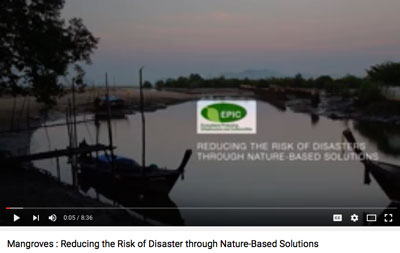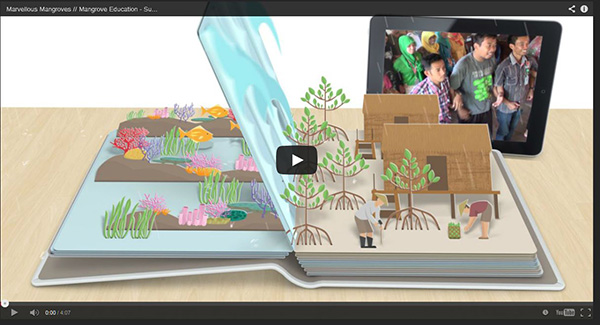|
The MAP News |
|
|
FEATURE STORY
Reclaiming mangroves for shrimp production THAILAND - For many years, farmer Noppadol Tawee lived with the constant fear of waking up and finding all the shrimp that were growing in his pond floating dead in the water. "The shrimp used to get sick, and I lost all of them several times. Some years, I could make a lot of money; in others, I could lose everything," explains Noppadol, a shrimp farmer living in Kanchanadit, a district in the province of Surat Thani in Southern Thailand. His neighbours advised him that the solution to his problem was related to a very specific kind of tree: the mangrove. Years ago, before shrimp production came to the region, mangroves had covered the coastline of the region, housing dozens of marine animals, including shrimp, small fish and crabs. Mangroves are known for purifying the waters and working as nurseries for a number of marine species, as well as being huge areas of carbon storage. But, since the early 1970s, the Thai government promoted semi-intensive and intensive shrimp production, which quickly spread to coastal areas, placing Thailand as the world's third-largest exporter of seafood and one of the main producers of shrimp in the world. This rapid expansion came at the cost of thousands of hectares of mangroves, a complex and rich ecosystem comprising different species of trees and a high number of other plants, animals and micro-organisms that grow in coastal areas in tropical regions. Noppadol's followed the advice of his community and planted mangroves. READ MORE AFRICA Protecting mangroves, Kenya's fishermen net cash – and more fish ASIA Protests for Sundarbans face police, BCL bar 'Let mangroves recover' to protect coasts INDONESIA - Allowing mangrove forests to recover naturally result in more resilient habitats that benefit both wildlife and people, say conservationists. In Indonesia, a Wetlands International project uses permeable dams to restore sediment needed for the trees to grow. The charity says early results suggest "ecological restoration" is more effective than planting programmes. More than half of the world's most at-risk habitats have been felled or lost over the past century, UN data shows. Mangroves are a group of about 80 different salt-tolerant species of trees that are able to live along the intertidal zones of coastlines in tropical and sub-tropical regions. The characteristic root systems of these trees allow them to withstand the ebb and flow of daily tides. The roots also act as buffers, slowing the flow of the tidal waters, allowing sediment to settle and build up as nutrient-rich mud. The unique habitats provide valuable shelter and breeding sites for fish, as well as stabilising coastlines, reducing erosion from storm surges and tsunamis. READ MORE Promises unmet as Thailand tries to reform shrimp industry The deep marketization of development in Bangladesh BANGLADESH - This article introduces the concept of ‘deep marketization’ as a relatively new, contemporary phase of neoliberal development policy in Bangladesh. By looking into the development strategy of the country’s energy sector, the article shows how an emphasis on marketization through public-private partnerships (PPPs) and other strategies advances a market fundamentalist agenda to strengthen the private sector and establish a world market. By drawing on interviews with development practitioners from various development organizations in Bangladesh, the article further reveals how development conceptualizations are shaped by the strategy of deep marketization, leading to the impoverishment of development by constraining its field of actions to measures based on the primacy of economic growth and private sector-led economic development, at the same time leading to a re-legitimization of flawed neoliberal development policies that result in further inequality, poverty and environmental degradation. READ MORE Ericsson's Connected Mangroves project wins UN climate change award Study cites mangroves as carbon sinks PHILIPPINES - Protected mangroves in this city have demonstrated the potential to serve as carbon sink by sequestering and storing considerable amounts of atmospheric carbon to mitigate the impacts of climate change, according to a state university study. The study, “Species Diversity, Above and Below Ground Biomass, and Carbon Stock Assessments of Selected Mangrove Forests in Iloilo City, Philippines” by Dr. Resurreccion Sadaba and Allen Grace Niego of the University of the Philippines in the Visayas, was one of six researches presented at the Regional Research Utilization Forum held today at the National Economic and Development Authority (NEDA) Region VI here. The study, which was presented by Dr. Sadaba at the forum, has also shown that it is possible to build low emission alternatives to develop economic resilience and sustainability projects at a minimal cost. It determined the diversity of mangroves and quantified the amount of above and below ground biomass and carbon stored among the selected sites of mangrove forest, which included 8 sites in four barangays of this city. The rapid economic development being undergone by the city was acknowledged by the study. READ MORE In CamSur, mangroves thrive again Indonesia’s best hope for slowing climate change AMERICA MAP Co-organizes “Sustainable Mangrove Economy” workshop as part of the World Congress of IUCN Latin American environmental defender attacked, hospitalized PERU - 2016 Goldman Environmental Prize winner Máxima Acuña de Chaupe was hospitalized after being attacked, allegedly by security forces hired by Minera Yanacocha, a subsidiary of Denver-based Newmont Mining, according to information provided by the Chaupe family. The attack took place on Máxima’s property in northern Peru that the mining company has been trying to obtain for its Conga gold mine project. “Minera Yanacocha must immediately stop their harassment of Máxima and her family, denounce attacks like this one, and call on its employees, agents and all others to ensure her safety,” said Earthworks’ Executive Director Jennifer Krill. The attack against Máxima is an alarming reminder of the murder earlier this year of Honduran activist Berta Cáceres. Berta was the 2015 Goldman Environmental Prize Winner from South and Central America. Both Berta and Máxima put their lives at risk by publicly denouncing multinational corporations threatening their communities. “Environmental defenders like Máxima, and the late Berta Cáceres before her, should not have to risk their lives to protect their homes and communities,” said Martin Wagner, managing attorney at Earthjustice. READ MORE ‘Hands on’ in the mangroves: Rookery Bay hosts National Estuaries Day How fig trees can help us save rainforests and wildlife, thanks to curious biology and deep roots in culture USA - A new book tells how fig trees have shaped our world, influenced diverse cultures and can help us restore life to degraded rainforests – all thanks to their curious biology. They are trees of life and trees of knowledge. They are wish-fulfillers … rainforest royalty. They are the fig trees, and they have affected humanity in profound but little-known ways. Mike Shanahan’s new book Gods, Wasps and Stranglers tells their amazing story. Fig trees fed our pre-human ancestors, influenced diverse cultures and played key roles in the dawn of civilization. They feature in every major religion, starring alongside Adam and Eve, Krishna and Buddha, Jesus and Muhammad. This is no coincidence – fig trees are special. They evolved when giant dinosaurs still roamed and have been shaping our world ever since. READ MORE OCEANA The silencing of the seas: how our oceans are going quiet. LAST WORD Dear Friends, Please find the following Link. The Nagenahiru Project on Solar Power for Night Fishing in Sri Lanka is selected as a finalist by the Water, Air and Food Foundation in Denmak. The Final winner will be selected by Public voting. Your co-operation is highly appreciate to cast more votes for our project. “The Sri Lankan Nagenahira Foundation has developed affordable LED lanterns for the artisanal fishermen fishing at night in the inland waters of Sri Lanka. Before this development, the use of kerosene lamps was polluting the air and aquatic ecosystem, affecting the health of communities and costing families a third of their income. The new LED lanterns are kerosene-free and powered by a rechargeable batteries and provide improved lighting for up to 16 hours. They are easy to maintain and cheaply rechargeable with photovoltaic panels, minimizing the environmental footprint.” VOTE HERE Kind Regards, Lal BACK TO TOP Not yet a subscriber? Click here to subscribe. Please cut and paste these news alerts/ action alerts on to your own lists and contacts. Help us spread the word and further generate letters of concern, as this can make a big difference in helping to halt a wrongdoing or encourage correct action.
|
Action Alerts:VOTE The Nagenahiru Project on Solar Power for Night Fishing in Sri Lanka is selected as a finalist by the Water, Air and Food Foundation in Denmak. VOTE HERE
|
Mangrove Action ProjectClick here to view past newsletters |
|
Mangrove Action Project's mission is to empower communities worldwide to restore, manage, and conserve mangrove forests. Through science, training, and environmental education, we provide nature-based solutions for people and our planet. MAP newsletter brings you news you can use: stories from around the globe pertaining to mangroves and the people who rely on them. To search a database of all MAP blogposts over the past 30 years, enter text in the box below. Thank you for loving the mangroves!





No comments:
Post a Comment
Note: Only a member of this blog may post a comment.